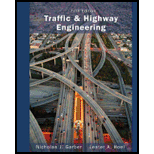
(a)
Average unit cost for operating a standard vehicle on a level roadway.
Answer to Problem 7P
Explanation of Solution
Calculation:
The average unit cost for operating a standard vehicle on a level roadway is as follows:
Let the depreciation cost per mile as
Let the registration and insurance cost per mile as
Let the maintenance cost per mile as
Let the fuel cost per mile as
The total cost required per mile by adding all the costs.
Total cost required per mile
Total cost required per mile
Conclusion:
Therefore, the average cost required for operating a standard vehicle on a level roadway is
(b)
Average unit cost for travel time for a truck.
Answer to Problem 7P
Explanation of Solution
Calculation:
The average unit cost for travel time for a truck.
Let the cost required per mile to operate the truck as
For the total unit costs using the relation
Substituting the values, we get
Substitute the value of
Let the average speed be
Substitute
Conclusion:
Therefore, the estimate average unit cost for travel time for a truck is
(c)
Average unit cost for single-vehicle property damage.
Answer to Problem 7P
Explanation of Solution
Calculation:
The average unit cost for single-vehicle property damage.
Substituting the values, we have
Conclusion:
Therefore, the average unit cost forsingle-vehicle property damage is
(d)
Average unit cost for personal injury.
Answer to Problem 7P
Explanation of Solution
Calculation:
The average unit cost for personal injury.
Let the cost for X-ray be equal to
Let the cost for emergency to be equal to
Conclusion:
Therefore, the average unit cost for personal injury is
(e)
The average unit cost for fatality.
Answer to Problem 7P
Explanation of Solution
Calculation:
The average unit cost for fatality.
It varies from $100,000 to $4.5 million.
Want to see more full solutions like this?
Chapter 13 Solutions
Traffic And Highway Engineering
- 6. A lake with no outlet is fed by a river with a constant flow of 1200 ft3/s. Water evaporates from the surface at a constant rate of 13 ft3/s per square mile of surface area. The surface area varies with the depth h (in feet) as A (square miles) = 4.5 + 5.5h. What is the equilibrium depth of the lake? Below what river discharge (volume flow rate) will the lake dry up?arrow_forwardProblem 5 (A, B, C and D are fixed). Find the reactions at A and D 8 k B 15 ft A -20 ft C 10 ft Darrow_forwardProblem 4 (A, B, E, D and F are all pin connected and C is fixed) Find the reactions at A, D and F 8 m B 6m E 12 kN D F 4 marrow_forward
- Problem 1 (A, C and D are pins) Find the reactions and A, C and D. D 6 m B 12 kN/m 8 m A C 6 marrow_forwardUniform Grade of Pipe Station of Point A is 9+50.00. Elevation Point A = 250.75.Station of Point B is 13+75.00. Elevation Point B = 244.10 1) Calculate flowline of pipe elevations at every 50 ft. interval (Half Station). 2) Tabulate station and elevation for each station like shown on example 3) Draw Sketcharrow_forward40m 150N B 40marrow_forward
- Note: Please accurately answer it!. I'll give it a thumbs up or down based on the answer quality and precision. Question: What is the group name of Sample B in problem 3 from the image?. By also using the ASTM flow chart!. This unit is soil mechanics btwarrow_forwardPick the rural location of a project site in Victoria, and its catchment area-not bigger than 25 sqkm, and given the below information, determine the rainfall intensity for ARI = 5, 50, 100 year storm event. Show all the details of the procedure. Each student must propose different length of streams and elevations. Use fig below as a sample only. Pt. E-ht. 95.0 200m 600m PLD-M. 91.0 300m Pt. C-93.0 300m PL.B-ht. 92.0 PL.F-ht. 96.0 500m Pt. A-M. 91.00 To be deemed satisfactory the solution must include: Q.F1.1.Choice of catchment location Q.F1.2. A sketch displaying length of stream and elevation Q.F1.3. Catchment's IFD obtained from the Buro of Metheorology for specified ARI Q.F1.4.Calculation of the time of concentration-this must include a detailed determination of the equivalent slope. Q.F1.5.Use must be made of the Bransby-Williams method for the determination of the equivalent slope. Q.F1.6.The graphical display of the estimation of intensities for ARI 5,50, 100 must be shown.arrow_forwardQUANTITY SURVEYINGarrow_forward
 Traffic and Highway EngineeringCivil EngineeringISBN:9781305156241Author:Garber, Nicholas J.Publisher:Cengage Learning
Traffic and Highway EngineeringCivil EngineeringISBN:9781305156241Author:Garber, Nicholas J.Publisher:Cengage Learning Solid Waste EngineeringCivil EngineeringISBN:9781305635203Author:Worrell, William A.Publisher:Cengage Learning,
Solid Waste EngineeringCivil EngineeringISBN:9781305635203Author:Worrell, William A.Publisher:Cengage Learning,

